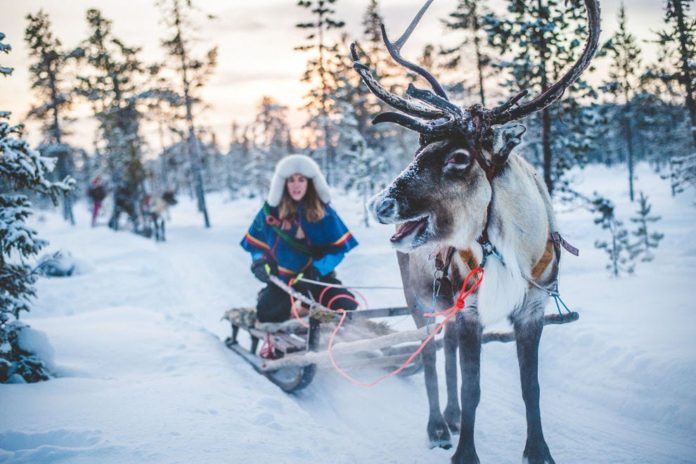Photo courtesy of Staffan Widstrand/imagebank.sweden.se
Sami community
Some 20,000 Sami live in Sweden, largely in the north. This indigenous Finno-Ugric community has their own language, flag, heritage and parliament. Many eco-tourism activities in Lapland, including reindeer sled rides and northern lights tours, are led by Sami guides.
 Photo courtesy of Swedish Lapland
Photo courtesy of Swedish Lapland
The northern lights
A highlight of a winter visit to Swedish Lapland is the chance to see the northern lights. Sweden’s proximity to the Arctic Circle makes it possible to experience the natural light display, a result of solar particles colliding with gases in the Earth’s atmosphere.
 Photo courtesy of Swedish Lapland
Photo courtesy of Swedish Lapland
Land of the midnight sun
If you’re in the very north of Sweden (above the Arctic Circle) during the two months around the summer solstice, you’ll notice that the sun doesn’t set. This allows for long days of outdoor adventure.
 Photo courtesy of Swedish Lapland
Photo courtesy of Swedish Lapland
The UNESCO-listed Gammelstad Church Town
The UNESCO World Heritage-listed Gammelstad Church Town is Sweden’s largest and best-preserved church town. Some 400 wooden houses surround the stone church, built in 1492. Guides in period costumes staff the open-air museum next to the church, offering a glimpse at what life was like in the village during the 1800s.
 Photo courtesy of Anders Blomqvist/imagebank.sweden.se
Photo courtesy of Anders Blomqvist/imagebank.sweden.se
Room with a view
A stay at Arctic Bath, a spa hotel on the Luleå River, means staying in a floating hotel that freezes into the ice in the winter, or in a cabin on land with floor-to-ceiling glass windows overlooking the wilderness.
 Photo courtesy of Lennart Pittja/Sápmi Nature/imagebank.sweden.se
Photo courtesy of Lennart Pittja/Sápmi Nature/imagebank.sweden.se
Glamping adventure
Chase the midnight sun or the northern lights on a glamping trip to Swedish Lapland. This region boasts numerous luxury camping experiences, including the Sápmi Nature Camp. Located north of the arctic circle, this glamping site welcomes guests to stay in Sámi tents and experience Sámi culture.
 Photo courtesy of Tina Stafrén/imagebank.sweden.se
Photo courtesy of Tina Stafrén/imagebank.sweden.se
Outdoor fika, a winter tradition
No matter the season or the region, the fika ranks as an important part of Swedish culture. Making time for fika means spending time with friends over a cup of coffee and a snack. The word ‘fika’ can be used as a noun or a verb, and you can fika just about anywhere.
 Photo courtesy of Pernilla Ahlsén/imagebank.sweden.se
Photo courtesy of Pernilla Ahlsén/imagebank.sweden.se
Coffee and kaffeost (coffee cheese)
In Northern Sweden, coffee is typically served with cubes of a squeaky cheese in a wooden Sámi cup known as a guksi. The warmth of the coffee softens the cheese and reduces its rubbery texture.
 Photo courtesy of Tina Stafrén/imagebank.sweden.se
Photo courtesy of Tina Stafrén/imagebank.sweden.se
Sleep in the trees
Treehotel, one of the most famous hotels in Sweden, lets guests sleep among the trees close to the Arctic Circle. Each tree room is suspended 13 to 20 feet above the ground. This room, known as the Mirrorcube, was designed by Tham & Videgård architects with mirrored glass.
 Photo courtesy of Asaf Kliger/imagebank.sweden.se
Photo courtesy of Asaf Kliger/imagebank.sweden.se
Jokkmokk Market
For more than four centuries, the Jokkmokk Market has served as a community gathering place. Held on the first Thursday every February, the market features concerts, exhibitions and shops selling Sámi handicrafts.
 Photo courtesy of Anna –hlund/imagebank.sweden.se
Photo courtesy of Anna –hlund/imagebank.sweden.se
Dog sledding
Dog sledding is a favorite winter adventure in Northern Sweden. Trips range from a couple of hours to days. A team of Huskies can cover between nine and 25 miles per day. As you zip through the snowy forests and across the icy flatlands, keep an eye out for reindeer, arctic hares, wolverines and even the occasional Arctic fox.
 Photo courtesy of Ted Logart/imagebank.sweden.se
Photo courtesy of Ted Logart/imagebank.sweden.se
On the water
During the summer months, Lapland’s thousands of lakes and numerous rivers set the scene for canoeing, kayaking and fishing. One of the best areas for a paddle is Skellefteå, the southern gateway to Swedish Lapland.
 Photo courtesy of Asaf Kliger/Icehotel/imagebank.sweden.se
Photo courtesy of Asaf Kliger/Icehotel/imagebank.sweden.se
World’s first ice hotel
The village of Jukkasjärvi is home to a Swedish icon, the original Icehotel. Opened in 1989, the year-round ice hotel features works of art carved into the ice by artists from around the globe. The ice blocks used to build the hotel each year are harvested from the Torne River.
 Photo courtesy of Anders Tedeholm/imagebank.sweden.se
Photo courtesy of Anders Tedeholm/imagebank.sweden.se
Fishing in Northern Sweden
No matter where you are in Sweden, water isn’t far away, Some nine percent of the country is comprised of rivers and lakes. The four national rivers and more than 30,000 lakes in Lapland make the region a fly fishing paradise.
 Photo courtesy of Swedish Lapland
Photo courtesy of Swedish Lapland
The king of the forest
Sweden is home to around 350,000 moose – known as the kings of the forest. Bulls can stand more than six feet tall, and each year, there are around 6,000 traffic accidents involving a moose.
 Photo courtesy of Swedish Lapland
Photo courtesy of Swedish Lapland
Wild blueberries
The policy of Allemansrätten, the “Right of Public Access,” allows everyone in Sweden to roam freely across the land. In the summer, this often means heading out into the wilderness to pick wild blueberries, lingonberries, cloudberries and mushrooms.
 Photo courtesy of Swedish Lapland
Photo courtesy of Swedish Lapland
Ice driving
When Lake Uddjaur freezes over, it becomes one of the world’s most unique driving schools. At Lapland Ice Driving, visitors can drive a Porsche, Lamborghini, Maserati or Ferrari across 15 miles of arctic ice track.
Credit: Source link






























